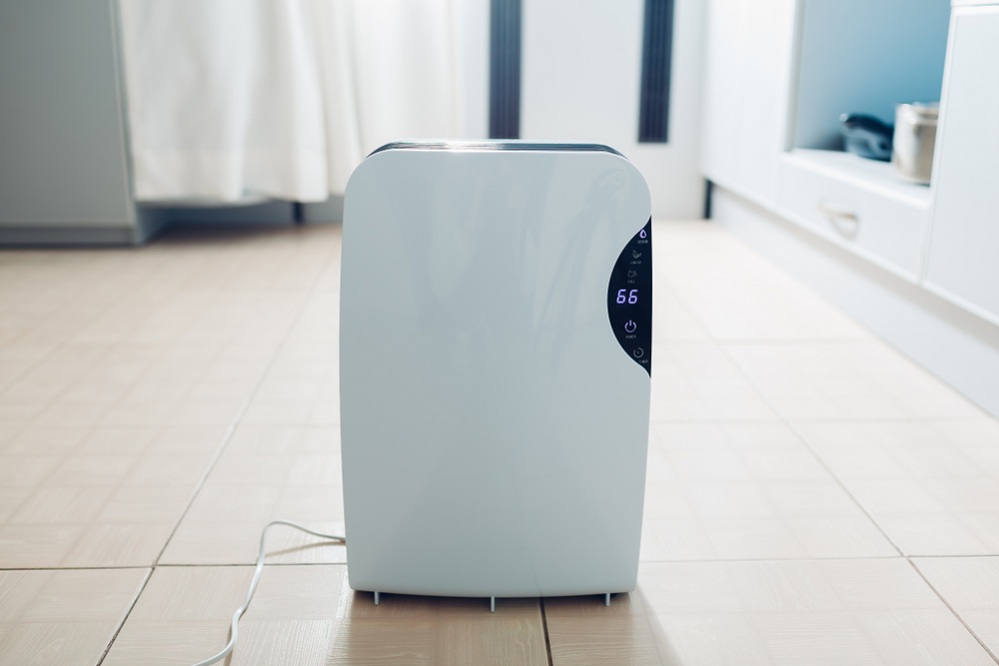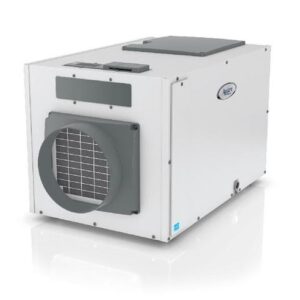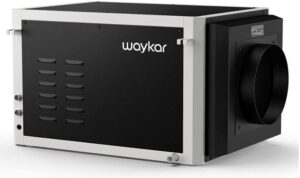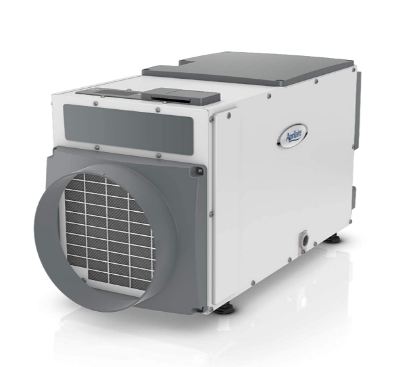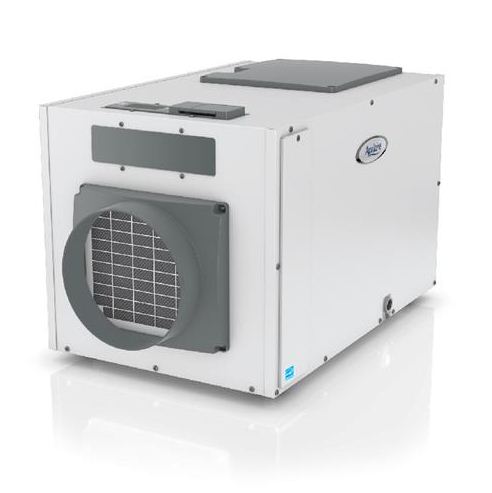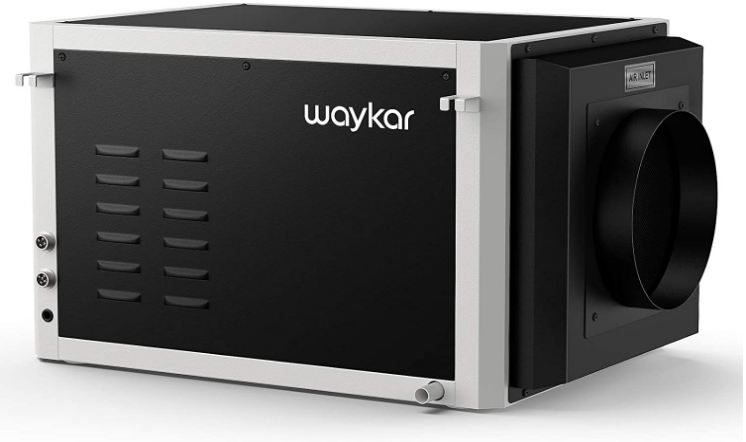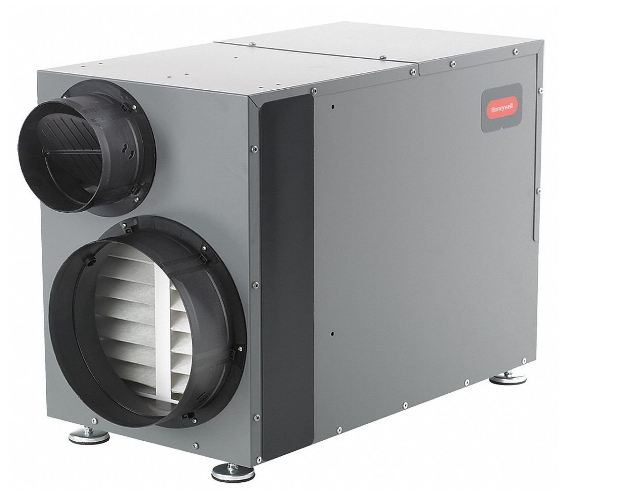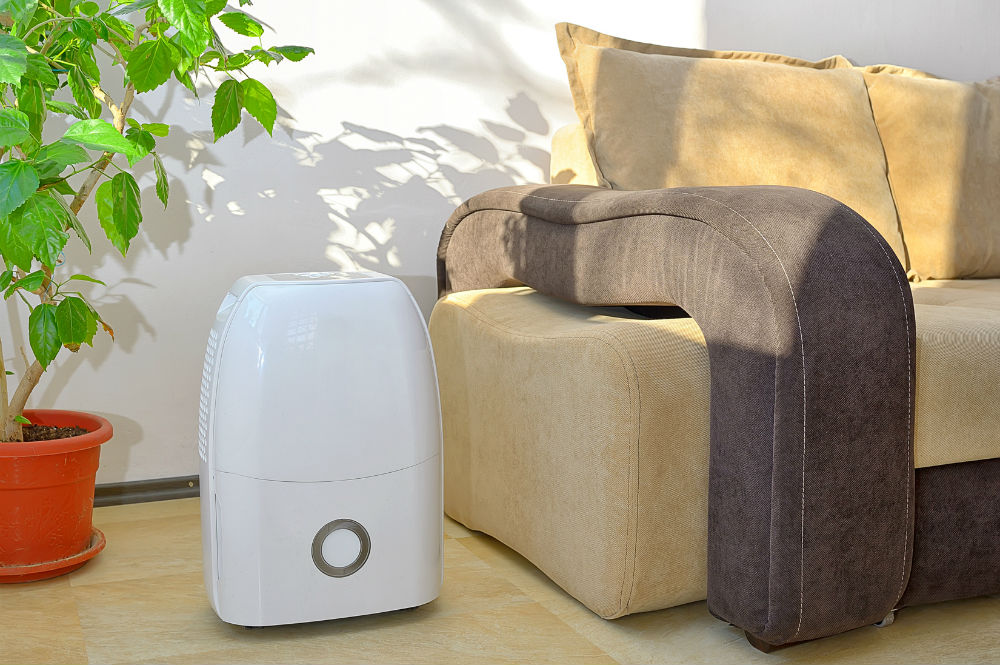Shopping for a whole-house dehumidifier?
You’ve landed on the right page.
When the air is damp it creates the perfect breeding ground for allergens like mold and mildew to thrive.
A reliable whole-house dehumidifier can permanently remove excess moisture from your entire home and keep it dry, leading to healthier air and less water damage to your floors, walls and furnishings..
Whole-house dehumidifiers actively monitor the humidity level in your home and regulate the relative humidity within a comfortable range.
To do this, the extract excess moisture from the air using several different methods.
In this article, we review some of the best whole house dehumidifiers sold today to help you understand what these units can do for you and to hopefully help you choose the right model for your home.
Our Top 3 Picks
- Dries up to 5,200 sqft
- Removes up to 95 pints per day
- A low-maintenance device
- Dries up to 7,200 sqft
- Removes up to 130 pints per day
- Leveling feet for proper placement
- Dries up to 6,500 sqft
- Removes up to 155 pints per day
- Defrost cycle for low temperature use
What’s In This Buying Guide
Table of Contents
In this buying guide, we discuss what we think are the best whole house dehumidifiers commercially available at the moment. It contains a list of our recommendations, followed by a comparison table describing their technical specifications, as well as a detailed review of each product.
We also provide a buying guide to help you understand the features and factors to consider when selecting a whole-home dehumidifier.
At the end we answer a few commonly-asked questions.
So let’s take a look at our top picks in a little more detail:
Best Whole House Dehumidifiers
- 1. Editor’s Choice: Aprilaire 1850
- 2. Best Value: Aprilaire 1870 XL Pro
- 3. Best for Low Budgets: Waykar Whole House Dehumidifier
- 4. Best for the Money: Honeywell Truedry DR90

Aprilaire 1850
Category
Editor’s ChoiceDimensions
27.5 x 12.5 x 14.5 inchesWeight
70 PoundsArea Coverage
Up to 5,200 Sq. ftCapacity
Up to 90 pints per dayCurrent Draw
8.0 AmpCondensate Pump
NoAuto Defrost
YesEnergy Star
NoWarranty
5 years
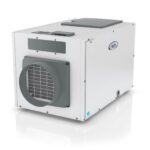
Aprilaire 1870 XL Pro
Category
Best ValueDimensions
30 x 19.5 x 18.75 inchesWeight
113 PoundsArea Coverage
up to 7,200 Sq. ftCapacity
Up to 130 pints per dayCurrent Draw
8.3 AmpCondensate Pump
NoAuto Defrost
YesEnergy Star
YesWarranty
5 years
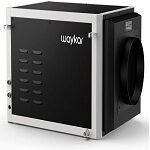
Waykar Whole House Dehumidifier
Category
Best for Low BudgeDimensions
25.6 x 18.1 x 14.1 inchesWeight
66 PoundsArea Coverage
Up to 6,500 Sq. ftCapacity
155 Pints per dayCurrent Draw
Not SpecifiedCondensate Pump
NoAuto Defrost
YesEnergy Star
NoWarranty
1 year

Honeywell Truedry DR90
Category
Best for the MoneyDimensions
34.8 x 18.8 x 25 inchesWeight
90 PoundsArea Coverage
2,800 Sq. ftCapacity
90 pints per dayCurrent Draw
6.7 AmpCondensate Pump
NoAuto Defrost
YesEnergy Star
YesWarranty
5 years r
The Aprilaire 1850 is a perfect solution for regulating the air moisture content around your home. It prevents the growth of mold and mildew while protecting your surfaces from condensation and carpets from becoming damp.
PROS
- Boasts quiet and noiseless operation
- Quality components and construction make it long-lasting
- Features an interactive display for easier usability
- Equipped with corrosion-resistant aluminum coils
CONS
- Does not have a built-in condensate removal pump
- Not Energy Star rated
Features
- Can cover areas up to 5,200 Sq. ft
- Removes up to 95 pints of moisture per day
- A low-maintenance device
- Minimizes airborne virus survival rate
- Effectively maintains humidity levels below 60%
Our Review
This device is a powerful offering from Aprilaire. It can cover areas as large as 5,200 Sq. ft and remove up to 95 pints of moisture per day. Even in whole-house dehumidifiers, this is a good capacity.
What makes this unit superior to others is its broad operating temperature range. It can operate in temperatures as low as 41°F and as high as 104°F without any difficulty.
Another standout feature of this machine is its auto-defrost function. For operating in low-temperature conditions, it starts its inbuilt blower to melt the ice freezing on the compressor, causing the dehumidifier to freeze up. This way, it continues to perform optimally without sustaining any damage.
It also features a washable MERV 8 filter for removing large particles and contaminants. It is essential to clear these because not only are they a threat to your health, but if they end up inside the machine, they can also damage the delicate components and circuitry.
Furthermore, when the filter is clogged, you can wash and reuse it again.
The device is fairly simple to operate largely because of its built-in humidistat. You can operate it at optimal levels by sustaining the humidity to whatever level you want.
Once set, the device will monitor the indoor humidity and start working when the humidity level rises above the set limit. And when the humidity level drops back to the required range, it will turn off automatically too.
This amazing whole-house dehumidifier from Aprilaire made it to our list for its extreme area coverage and moisture removal rate.
It is simple to use with an interactive display and is installed in the ductwork of your HVAC for automatic operation. With this unit, there are no trays to empty or leaks to clean up.
PROS
- Durably built with quality components
- Durably built with quality components
- Equipped with corrosion-resistant aluminum coils
- Built-in in humidistat makes operation easier
- Energy Star rated for low energy consumption
- Auto defrost function allows it to operate in low temperatures
CONS
- Bulkier than most whole-house dehumidifiers
- Expensive
Features
- Works well for areas up to 7,200 Sq. ft
- Capable of removing 130 pints of water per day
- Capable of removing 130 pints of water per day
- Has leveling feet for proper placement
- Makes use of gravitational pull for drainage
- Includes auto-shutoff and restart features
Our Review
Aprilaire is the number one manufacturer of HVAC dehumidifiers. The 1870 XL breaks all its records with its powerful performance and extreme durability.
Although it has all the features standard in most HVAC dehumidifiers, the area coverage and moisture removal capacity are where it truly shines. It can effortlessly cover an area of 7,200 Sq. ft with its capacity of removing 130 pints of water vapor from the air in 24 hours.
Other features include a built-in humidistat for ease of operation. It monitors the humidity levels around the house and works with the thermostat to maintain uniform levels everywhere.
To increase its operating temperature range, manufacturers have equipped it with a blower. When the temperature drops and ice starts forming on the compressor, it turns on to thaw it and reverts the device back to its operational state.
There is no condensate pump inside this machine. However, it uses the earth’s gravitational to its advantage by using it to expel the water out continuously.
You can purchase this model in ducted and non-ducted variations. However, we would suggest going for the ducted version because it is more efficient.
The device is Energy Star certified for lower energy consumption, so with this, you won’t have to worry about hefty bills breaking your bank. Furthermore, it comes with a five-year warranty coverage so you can invest your money with peace of mind.
Waykar is a trusted name in the world of air purifying products. This Waykar model has all the standard features of a whole-house dehumidifier yet has some unique features that set it apart.
PROS
- Durably built with quality components
- Equipped with corrosion-resistant aluminum coils
- Built-in in humidistat makes operation easier
- Energy Star rated for low energy consumption
- Auto defrost function allows it to operate in low temperatures
CONS
- Bulkier than most whole-house dehumidifiers
- Expensive
Features
- Suitable for areas up to 6,500 Sq. ft
- Extracts up to 155 pints of excess moisture per day
- Has a defrost cycle for operating in low temperatures
- Covered with a 30-day money-back guarantee
- Comes at a surprisingly affordable price
Our Review
If you want a reliable unit to dehumidify your entire house, this Waykar dehumidifier is an exceptional option that you should not miss.
It is a high-efficiency device with a moisture removal rate of 155 pints every day. Thanks to this, it can cover large areas extending up to 6,500 square feet, so you can rely on it to create a comfortable atmosphere for your home.
It has all the standard features of a whole-house dehumidifier. These include a built-in humidistat to monitor and regulate the desired humidity levels, an auto-defrost to thaw and remove ice forming inside the machine during low temperatures, and an auto-shutoff and restart for safe operation.
Yet, the standout feature of this device is its external humidity sensor. It comes with a 5-meter-long wire that plugs into the unit.
With this, you can have the machine control the humidity levels remotely. Additionally, it comes with an intelligent touch control panel that allows you to easily control the actions of its top-notch operation.
Because it is reasonably priced, don’t assume it to be low in quality. For quality assurance, Waykar has a comprehensive warranty that starts with a 30-day money-back guarantee.
So even after purchase, if you are not satisfied with its performance, you can return it to get your money back within 30 days. It also comes with a one-year warranty.
Honeywell is an established manufacturer of energy-efficient products. So, with the Truedry DR90, you can trust it to provide you with a quality unit that will not burden your pocket with its power consumption.
PROS
- Energy Star certified for energy-efficient performance
- It comes with a hose for continuous drainage
- Supports remote control operation
- Condensation coils are protected in an anti-corrosive coating
- Sturdy and rugged construction makes it long-lasting
CONS
- Noisier than other units on this list
- Warranty coverage requires installation by a company contractor
Features
- Removes up to 90 pints of dampness from the air
- Has an area coverage of up to 2,800 Sq. ft
- Convenient and straightforward to use
- Requires little maintenance and periodic cleaning
- Design is relatively compact yet elegant
Our Review
Truedry DR90 can be defined as a small and compact unit that can remove excess moisture from your entire house.
With its 2,800 square feet area coverage, it can remove up to 90 pints of airborne moisture per day. Even at this rate, it only draws 24 volts, making it one of the most energy-efficient units out there. Its 3.0 Energy Star certification also confirms this.
The unit is ruggedly built with quality components. Manufacturers have made sure to make it long-lasting by coating its coils in an anti-corrosive substance. It is also very low-maintenance and requires periodic cleaning and annual maintenance to keep performing optimally.
We really like it for its inbuilt fresh air supply vent. It allows the unit to bring in fresh air from outside to replace the damp indoor air. This way, it won’t recycle the same air, again and again, providing you with better-quality air to breathe in comfortably.
Lastly, it comes with five-year warranty coverage, but in order to avail of it, you should get the device installed with a company-registered professional. This means it should be installed as per the company’s directions and set in a position where it can operate at its best.
Whole House Dehumidifier Buying Guide
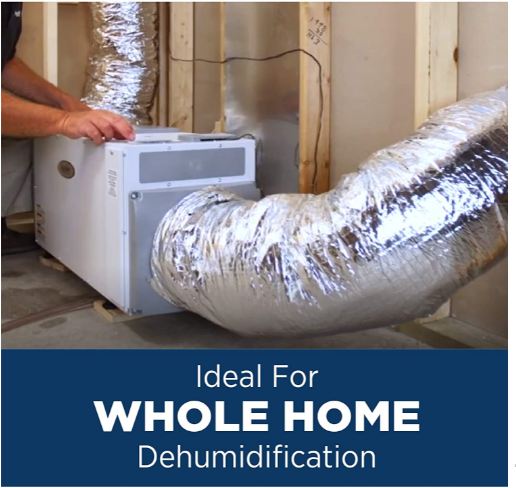
What is a Whole House Dehumidifier – and How does it work?
The primary purpose of a whole-house dehumidifier is to extract and remove the extra moisture from your home environment. It does so either by refrigeration or by absorption/adsorption.
Refrigeration
Dehumidifiers that work on the refrigeration principle take in the humid air from one side of the device.
Once inside, the air passes over a cooling condensation coil, turning the moisture from vapors into liquid water. This water is then collected inside a built-in water reservoir or is drained out via a hose.
Now devoid of moisture, the cool air passes over a heating element that restores the air to its original temperature. The dry air blows back into the room from the other end of the device.
Absorption/Adsorption
Dehumidifiers that work via absorption or adsorption use water-absorbing chemicals to remove the moisture from the air.
First, the fan sucks in the humid air. It then passes over the desiccant material installed over a wheel, which removes the moisture via absorption or adsorption.
The dry air is then released back into the room. Such dehumidifiers work like a sponge, but they also have an internal heating system that regenerates the desiccant material.
Types of Whole House Dehumidifiers
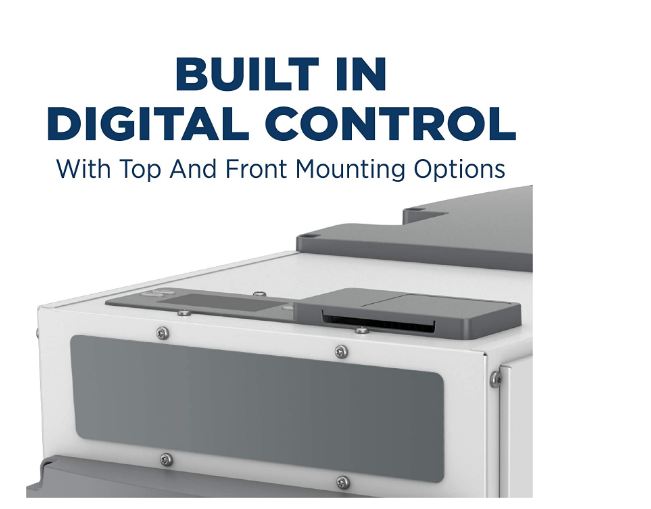
Unlike portable residential dehumidifiers, whole-house dehumidifiers are mostly fixed units that connect to your house’s ductwork to dehumidify indoor air. Depending upon their operation, whole-house dehumidifiers are classified into different categories such as:
Compressor
Dehumidifiers that employ refrigeration technology for extracting moisture from the air are termed compressor dehumidifiers. Their operation is quite similar to that of an air conditioner; however, they are more effective at regulating humidity levels.
Compressor models are the most commonly used dehumidifiers.
Chemical Absorbent
Also termed as desiccant dehumidifiers, these dehumidifiers use a water-absorbent chemical to soak the moisture from the air.
Although their operation may appear simple, they consume a lot of energy, making them hefty for residential usage. They are more commonly found in industrial settings.
Dehumidifying Ventilators
Dehumidifying ventilators are simple machines more commonly used for basements. They consist of a sensor and an exhaust fan.
The sensor functions like a humidistat monitoring the relative humidity level. It triggers the unit on or off when the set humidity levels are crossed or reached. However, dehumidifying ventilators are not as effective as modern dehumidifiers.
Why Choose a Whole House Dehumidifier over Stand Alone Units?
As the name suggests, a whole-house dehumidifier works to dehumidify the entire house. They are installed in your HVAC ductwork, so they stay out of sight, but they work with the thermostat to regulate the humidity levels around the house.
Being automatic in their operation, they are more energy-efficient than stand-alone units. Moreover, they require minimal maintenance once a year.
On the other hand, stand-alone units are suitable for dehumidifying any one room at a given time. They take up some space in your home, which can be a problem if you are particular about home decor.
They are somewhat noisy and require regular maintenance to prevent mold and mildew from growing inside the unit. Lastly, they are not as efficient as whole-house dehumidifiers and may put a burden on your energy bills.
What to look for in a Whole House Dehumidifiers
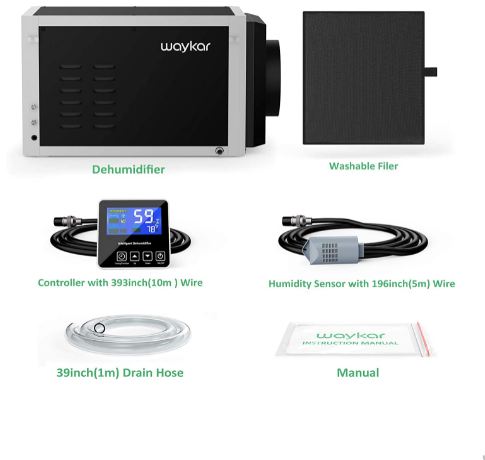
There is a huge range of whole house dehumidifiers available on the market. Yet not all the models are reliable and efficient. To pick out a good unit for yourself, you should keep the following in mind:
Area Coverage
Area coverage is the most crucial consideration in a whole-house dehumidifier. Since you want to use it for the entire house, you have to know whether it can cover it or not.
Most whole-house dehumidifiers can cover areas more than 2,000 Sq. ft. But knowing the exact square footage of your house will help you find the most suitable unit for your home.
However, choosing a model with a broader range will facilitate you when the conditions are extreme, like during heavy rains and storms. This way, your system won’t have to overwork itself.
Drainage
Most whole-house dehumidifiers lack a built-in water reservoir to collect the liquified moisture. They employ a direct-to-drain method to expel out the extracted water.
For this purpose, some units have a built-in condensate pump to push the water out of the system, while others rely on the earth’s gravitational pull to drain it out.
Units with pumps can channel the water in any direction, even vertically. But units that employ gravity drainage need to be set up on a surface higher than the drainage outlet; otherwise, they will fail to collect water.
Because they expand your placement and drainage options, we suggest you go with a unit with an integrated pump.
Noise Levels
A fan is an essential component of any dehumidifier. Depending upon their size and capacity, these fans make noise. This noise is further amplified because of the vibration and movement of the compressor, pump, and other parts of the machine.
Of course, all this buzz can irritate anyone, so you should look for a device that does not produce more than 60 dB at any speed. Considering 50 dB is the noise level of a normal conversation, 60 dB is a good target noise level to look for.
Power Source and Efficiency

Ducted dehumidifiers are integrated into the centralized HVAC system, so they will be directly hooked with the electric supply line of your house. They work with the thermostat to automatically switch on and off so you won’t be bothered with manual operation.
Since they work to remove moisture from the entire house, you might believe them to consume a lot of energy. Surprisingly, these units actually consume less energy than standalone units.
Some are even certified with an Energy Star for their energy efficiency. We advise that you look for such a unit to keep the bills under control.
Maintenance Costs
Ducted, in-line dehumidifiers are low-maintenance devices that usually require annual maintenance. Even so, you should look for a unit with lower maintenance costs because you have already spent lots of money on its purchase and installation.
Durability
Quality components and construction of the device determine its time of service. A ruggedly-built device will continue to serve you for years, while a device lacking durability can fail within months.
Always inspect the build quality and sturdiness of anything you are purchasing. And when it comes to dehumidifiers, look for a model with a sturdy chassis, waterproofing, corrosion resistance, and rugged exterior, as all these features render the unit durable and long-lasting.
Pros and Cons
Besides being bad for your health and home, high humidity also makes you feel hot and sticky. Even on days when the temperature is pleasant, it can make you feel quite uncomfortable.
So, it’s natural that you look for a whole-house dehumidifier to rescue you and your home. Yet this useful appliance has some shortcomings, too.
Pros
Maintain Uniform Humidity
These devices install in the ductwork of your house and use vents to dehumidify every area. Vents around the house suck in the humid air. Dehumidifiers then make the atmosphere less humid (or dry) and send it back.
Once you set the desired humidity range, the device will continue to work until that range is achieved throughout the house.
Automatic Operation
Whole-house dehumidifiers work with the thermostat of your house to monitor humidity levels. Whenever the moisture content rises above the desired range, the device turns on automatically to lower it. And once that range is reached, it turns off automatically as well.
So, all you have to do is set the desired humidity range, and the device will do all the rest.
Low maintenance
Unlike their portable counterparts, whole-house dehumidifiers are quite low-maintenance. Since they employ direct-to-drain water drainage via a hose, you don’t have to be bothered with emptying water buckets. All they need is an annual maintenance check to ensure proper function.
Stay out of Sight
The biggest advantage of a whole-house dehumidifier is that it is installed out of sight. It connects to the ductwork of your HVAC system, so it won’t be on display.
Anyone who takes their home decor seriously will love this feature because portable dehumidifiers are usually bulky units that take up some precious household space and interfere with the aesthetics of the place.
Cons
High Upfront Cost
Because of their higher capacity and powerful performance, whole-house dehumidifiers tend to have a high upfront cost. But they are a one-time investment costing anywhere between $1,000 and $2,000.
You may opt to purchase a portable dehumidifier, but you will need to move it from one room to another to dehumidify it. Meanwhile, a whole-house dehumidifier will do it automatically for you.
Require Professional Installation
Since a whole-house dehumidifier works as a part of your main ductwork, it is better to have professionals install it for you.
Sure, some able DIYers can nail the job well, but the warranty coverage of most units calls for professional installation; otherwise, it will be void. Therefore, along with the high upfront costs, you will have to think about its installation costs too.
Frequently Asked Questions
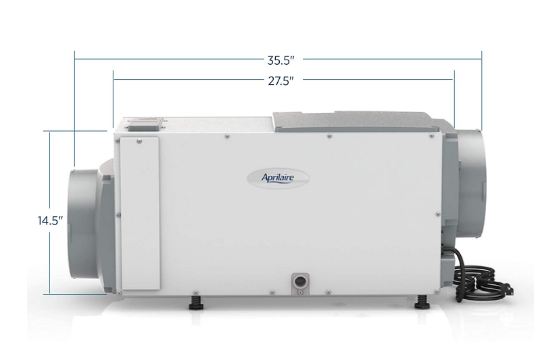
Do whole-house dehumidifiers last long?
The lifespan of a whole-house dehumidifier primarily depends on its usage and maintenance. When used properly and maintained regularly, a whole-house dehumidifier can last more than five years. Some units can also provide ten years of service if you use them with the utmost care.
How much do whole-house dehumidifiers cost to run?
Contrary to what most people think, whole-house dehumidifiers are not power-consuming. In fact, they actually consume lesser energy than their portable counterparts.
While collecting 3 to 150 pints of water per day, whole-house dehumidifiers cost about \$15 to \$25 per month and about \$60 to \$300 per year.
How much do whole-house dehumidifiers cost to run?
Contrary to what most people think, whole-house dehumidifiers are not power-consuming. In fact, they actually consume lesser energy than their portable counterparts.
While collecting 3 to 150 pints of water per day, whole-house dehumidifiers cost about \$15 to \$25 per month and about \$60 to \$300 per year.
Is it possible to remove all the extra humidity from the house with a whole-house dehumidifier?
Yes, it is possible to remove all the extra humidity from the house with a whole-house dehumidifier. But we would suggest doing otherwise.
Dry air is just as problematic as humid air. For one, it causes our eyes, lips, skin, and sinuses to become dry. It also damages the different materials around our house.
So, we advise setting your whole-house dehumidifier at modest ranges so that you can keep the moisture levels of your home at an ideal level and can avoid having to face any of these problems.
Final Verdict: What is the Best Whole House Dehumidifier?
Keeping everything in mind, we find the Aprilaire 1850 to be the best whole house dehumidifier out of all the other options we’vereviewed in this guide.
But if you want something with a larger area coverage, we would suggest you go for Aprilaire 1870 XL Pro
Lastly, for those who want to stick to their budgets, Waykar Whole House Dehumidifier is a good choice.
I’m a degreed ME (mechanical engineer) who is passionate about machines of all kinds. I created MachineWonders.com as a way to connect with others who love machines like me – or need help choosing one for their needs, application, or situation.

